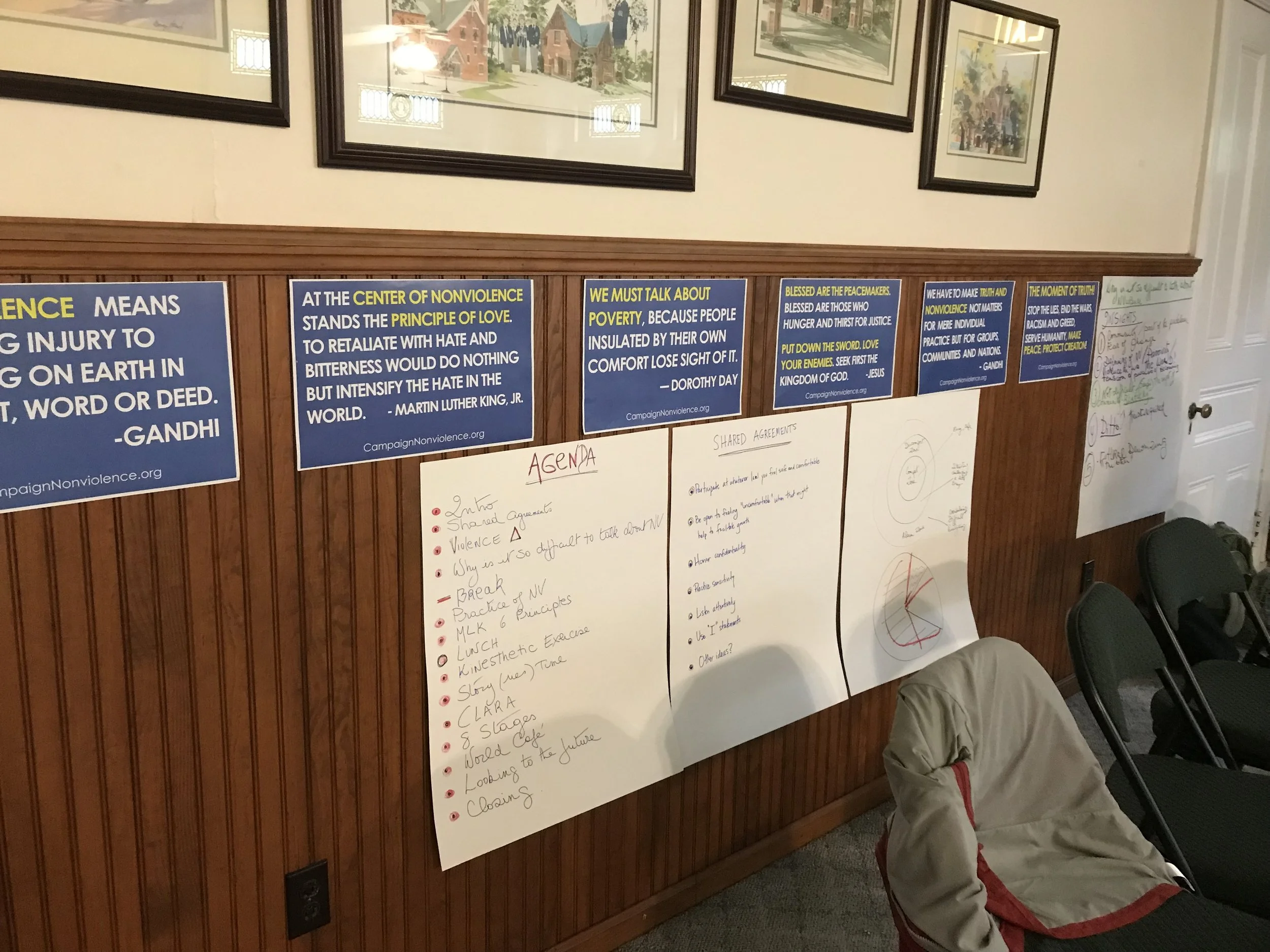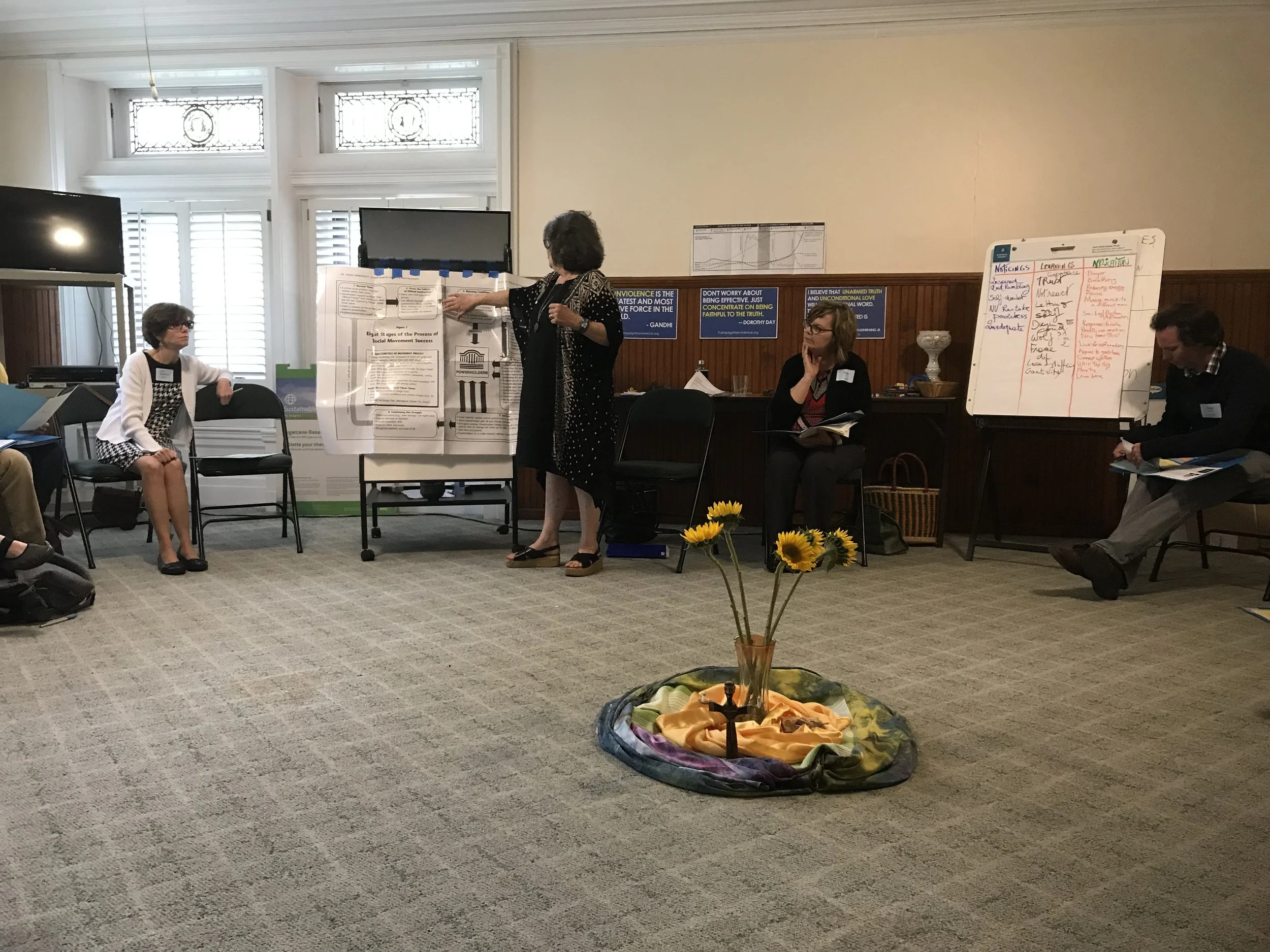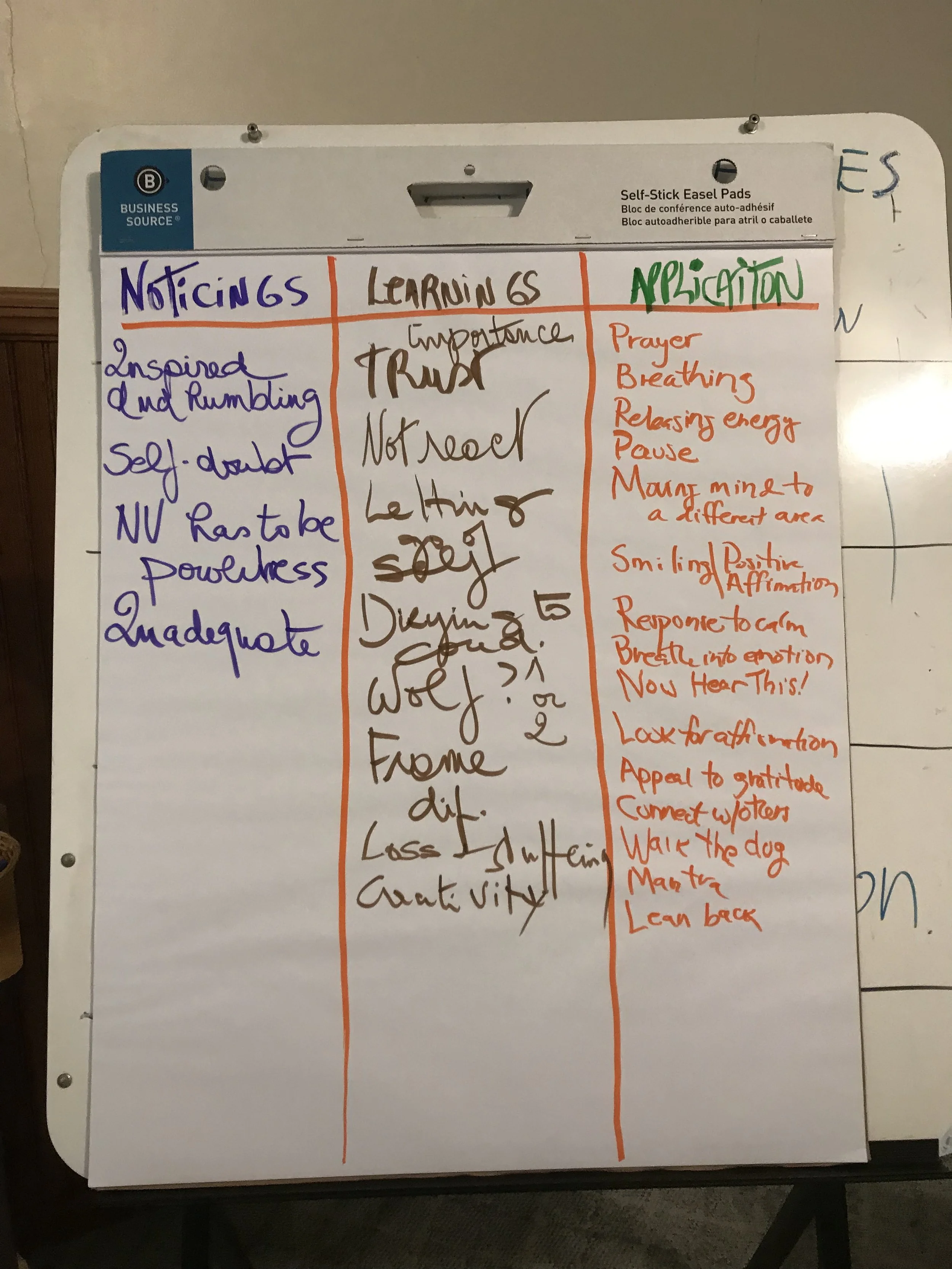Upon This Rock We Shall Rebuild Our Church
by Veronica Pelicaric, Pace e Bene Coordinator of International Programs
Villanova University, a Catholic and Augustinian university outside of Philadelphia, Pennsylvania, invited Pace e Bene to give a one-day training for staff and faculty on May 9, 2019 workshop. The inspiration for this event came from Diane Nash, who underscored the importance of training when giving a lecture at Villanova last year. The staff of the Center for Peace and Justice Education, Campus Ministry, and Student Life responded to the call and made the training happen with outstanding commitment and competence. The workshop was filled to capacity and it took place in a beautiful setting at the IHM Spirituality Center in Bryn Mawr, Pennsylvania. Next year, this group of staff and faculty hope to have a similar training for students.
How many of us Catholics see the connection between Jesus and nonviolence? Very few until now. But as the practice and principles of nonviolence are gaining traction throughout the world, that connection is becoming unavoidable. As Pace e Bene’s John Dear has shown in his many books, Jesus' life is the story of nonviolence. Called “my beloved son” by God at his baptism, Jesus will later say in the Sermon on the Mount (Matt 6:24) that the beloved sons and daughters of God are blessed peacemakers. Peacemakers are the children of the God of peace. To the very end, Jesus remained faithful to that identity, and called all those who follow him to do the same.
When Gandhi died, two books were found next to his bedside: The Bhagavad Gita and the Bible. He found inspiration and solace in these two seminal books and made the connection that led him to proclaim that “nonviolence is the greatest and most active force in the world” and that “nonviolence is the highest expression of humanity's conscious state.” Pope Francis titled his 2017 message for the World Day of Peace “Nonviolence: A Style of Politics for Peace.” In a world rife with nuclear threat, environmental crisis, and feelings of hopelessness and helplessness which we drown in consumerism or numb with the latest gadget, these messages could not be more timely. It is time to wake up to a new story and apply it in our personal lives, in our relationships, and in concern and action for social and global welfare.
It is in this new paradigm that we will find what we all are looking for: inner peace. In the same Sermon on the Mount, Jesus talks about not worrying and not being anxious. How does our crippling and harmful stress lead to the violence of consumerism which perpetuates our system of global injustice? In workshops we create the space to ask this important question and experience many teaching and learning moments.
The following is a rough summary of the workshop. My hope is that reading this might encourage some people to organize nonviolent trainings in their communities, educational facilities, and other relevant venues. Needless to say, a workshop like this one can only provide a bird's eye view of the nonviolent path. But, as the saying goes, the journey of a thousand miles begins with one step.
We began with a centering exercise followed by introductions punctuated with the participant's expectations. After shared agreements to create safe space, we touched on Gospel stories that highlight three fundamental expressions of violence: direct, structural, and cultural. The Man with the Withered Hand (Luke 6:6-11), the Good Samaritan (Luke 10:30-37), and the Woman Accused of Adultery (John 8:1-11) speak of oppression as evidenced in patriarchy, hierarchy and racism. These were as alive in Jesus’ time as they are today.
Using creative, active, and powerful nonviolence, Jesus prioritizes the law of love over the law of people. He teaches that serving, not dominating, makes humans great. Furthermore, when he turns the other cheek, he denies the oppressor the right to humiliate him and thus refuses to cooperate with humiliation, a very important aspect of nonviolence. (For an in depth explanation of this reading on turning the other cheek, I recommend Walter Wink's little book Jesus and Nonviolence.)
Stereotypes of nonviolence—that it is passive, ineffectual, and cowardly, for example—are hard to ignore. Yet to simply state this misconception would not be very meaningful. So asking the question “Why is it so difficult to talk about nonviolence?” opened the possibility for people in small groups to discover the answer by themselves. And so they did. When scrutinizing the lives and motivations of nonviolent heroes, it is clear that the practice of nonviolence is much more arduous than the practice of violence and requires a soul-force not easily accessed.
The impact of nonviolence on human and non-human life is so very different as well. Erica Chenoweth, in her seminal book Why Civil Resistance Works, explains that nonviolent movements are twice as successful as violent ones. Giving historical examples, she states that when 3.5% of the population engages in active and strategic nonviolent resistance, it changes everything—toppling dictators and resolving issues without further bloodshed. A striking piece of news delivering a message of hope worthy of our consideration!
When people first encounter these teachings they sometimes feel discouraged, guilty, and wonder how they could possibly make a difference. The visual symbol of The Two Hands of Nonviolence is a powerful reminder that we can train moment to moment by saying no to injustice and yes to truth and brotherhood. With one hand (the stop sign) I refuse to cooperate, but with the other hand extended I offer to work together in finding a better solution that honors our common humanity.
Educating ourselves can be done in so many different ways once we open our eyes and decide to be peacemakers. To strengthen this possibility, we revised Rene Girard's Mimetic Theory and Walter Wink's statement that the myth of redemptive violence has been played out since Babylonian times. (Presented by Patty Hall, co-facilitator in the training.) We are conditioned to believe that violence will end violence, and we reinforce this notion in our modern media, entertainment, and politics. That is why Jesus' nonviolent message is so important: He has offered a third way to passivity or violence—militant nonviolence.
Before lunch, we discussed Dr. Martin Luther King's Six Principles of Nonviolence in small groups, generating a great deal of enthusiasm and reflection. To counterbalance the after- lunch doldrums, we engaged in a kinesthetic exercises that sustained people for the rest of the day. It was then time to tell nonviolent stories, Gospel-related and otherwise, that provide a rich source of learning and inspiration, highlighting our shared humanity and the deepest longing in our heart: to be of service and make a difference.
A five step process for nonviolent engagement, which we have called CLARA (Center, Learn, Articulate, Receive, and Anchor) came next. We learned about how each of us finds our “main seat”, both in the moment and otherwise, by connecting to our breath and doing practices to lessen reactivity. We learned about mapping conflicts through acknowledging needs and fears and also how to understand issues through awareness of attitudes, behaviors, and context. We spoke about best ways to articulate our situation, to receive the truth of others, and how to anchor agreements.
Bill Moyer, an engineer, saw that social movements follow very precise stages which he called MAP (Movement Action Plan), better known as Eight Stages of Social Movements. With time running at my heels, I explained this process using the Civil Rights Movement as a model. Time constraints become so real to facilitators at this point in the day! This was no exception.
The final exercise revolved around five questions concerning the visioning of nonviolent Gospel communities. For this to be truly experiential, we went for inspiration to a process called The World Cafe (www.theworldcafe.com). We divided participants into five groups, allotting a question per group written on a big sheet on a table. They responded to their question and then rotated through the other four tables to add to what was already written there. This gives very rich input in a very short time.
As homework, people were asked to report back to the organizers on the relevance of the day's content to the work done at Villanova and how this might be included in a training for students.
We ended with a beautiful closing exercise that fosters a tangible and soulful experience of our human interconnectedness and the possibility of working together to create a humane society.
In an interview held some years ago, Jean Vanier said that in order to be good Christians we had to be a bit crazy—crazy for Jesus and for peace. It is up to each one of us to figure out how we might live out this craziness. And in all probability, it will bring us to sanity.
Jean Vanier ended the interview exclaiming: “Jesus is Incredible!” And to that we can only add: Indeed.
* * *
If you are considering scheduling a workshop for your organization, don’t take our word about the benefits of what we have to offer. Listen instead to the people who have experienced it for themselves in the comments below from our Villanova University post-workshop evaluations:
“I am profoundly grateful for this day—it has called me to real self-reflection and inspired me to think about ways to center non-violence in my work and in my own spiritual growth and becoming. The closing exercise was incredibly powerful. Thank you!”
“I loved the interactive elements of the workshop and the opportunity to engage the full self: body, mind, emotions, soul/spirit, and to engage inter/intra-personally. Thank You!”
“I am excited to see how we will apply what we learned on campus!”
“I am grateful for the time, attention, and skill of the facilitators. I feel open to possibilities for letting go, waking up, and standing up.”
“The most important thing I learned was the need to actively promote non-violence, not just avoid violence.”
“To me the best things about this workshop were:
1) Seamless flow of theory and quotes—narrative examples—discussion, processing, sharing
2) The depth, experience, and soulful wisdom of the facilitators was healing/restoring/consoling/centering/inspiring.”






